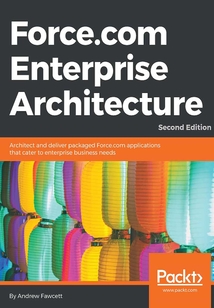舉報 

會員
Force.com Enterprise Architecture(Second Edition)
最新章節(jié):
Index
ThisbookisforadvancedForce.comdevelopersandarchitectswhoneedtounderstandtheSalesforceplatformfromtheperspectiveofenterprise-levelrequirements.ApriorunderstandingofApexandVisualforceisamust.ThosefamiliarwithotherenterprisesoftwareecosystemswillalsofindthisbookidealastheyadoptForce.com.
目錄(140章)
倒序
- 封面
- 版權(quán)信息
- Credits
- Foreword
- About the Author
- Acknowledgements
- About the Reviewers
- www.PacktPub.com
- Customer Feedback
- Preface
- Chapter 1. Building Publishing and Supporting Your Application
- Required organizations
- Introducing the book's sample application
- Package types and benefits
- Creating your first managed package
- Package dependencies and uploading
- Becoming a Salesforce partner and benefits
- Introduction to AppExchange and listings
- Installing and testing your package
- Licensing
- Providing support
- Customer metrics
- Trialforce and Test Drive
- Summary
- Chapter 2. Leveraging Platform Features
- Packaging and upgradable components
- Understanding the custom field features
- Understanding the available security features
- Platform APIs
- Localization and translation
- Building customizable user interfaces
- E-mail customization with e-mail templates
- Process Builder Workflow and Flow
- Social features and mobile
- Summary
- Chapter 3. Application Storage
- Mapping out end user storage requirements
- Understanding the different storage types
- Reusing the existing Standard Objects
- Importing and exporting data
- Options for replicating and archiving data
- External data sources
- Summary
- Chapter 4. Apex Execution and Separation of Concerns
- Execution contexts
- Apex governors and namespaces
- Where is Apex used?
- Separation of Concerns
- Patterns of Enterprise Application Architecture
- Unit testing versus system testing
- Packaging the code
- Summary
- Chapter 5. Application Service Layer
- Introducing the Service layer pattern
- Implementation of design guidelines
- Handling DML with the Unit Of Work pattern
- Services calling services
- Contract Driven Development
- Testing the Service layer
- Calling the Service layer
- Summary
- Chapter 6. Application Domain Layer
- Introducing the Domain layer pattern
- Implementation design guidelines
- Domain class template
- Implementing Domain Trigger logic
- Implementing custom Domain logic
- Object-oriented programming
- Testing the Domain layer
- Calling the Domain layer
- Updating the FormulaForce package
- Summary
- Chapter 7. Application Selector Layer
- Introducing the Selector layer pattern
- Implementing design guidelines
- The Selector class template
- Implementing the standard query logic
- Implementing custom query logic
- Introducing the Selector factory
- Updating the FormulaForce package
- Summary
- Chapter 8. User Interface
- Which devices should you target?
- Introducing Salesforce Standard UIs and Lightning
- Leveraging the Salesforce standard UIs
- Generating downloadable content
- Generating printable content
- Client server communication
- Managing limits
- Object and field-level security
- Managing performance and response times
- Using the Service layer and database access
- Considerations for using JavaScript libraries
- Custom Publisher Actions
- Creating websites and communities
- Mobile application strategy
- Custom reporting and the Analytics API
- Updating the FormulaForce package
- Summary
- Chapter 9. Lightning
- Building a basic Lightning user interface
- Lightning architecture
- FormulaForce Lightning Components
- Making components customizable
- Integrating with Lightning Experience
- Lightning Out and Visualforce
- Integrating with communities
- Testing
- Updating the FormulaForce package
- Summary
- Chapter 10. Providing Integration and Extensibility
- Reviewing your integration and extensibility needs
- Force.com platform APIs for integration
- Application integration APIs
- Exposing Lightning Components
- Extending Process Builder and Visualflow
- Alignment with Force.com extensibility features
- Extending the application logic with Apex interfaces
- Summary
- Chapter 11. Asynchronous Processing and Big Data Volumes
- Creating test data for volume testing
- Indexes being selective and query optimization
- Skinny tables
- Asynchronous execution contexts
- Volume testing
- Summary
- Chapter 12. Unit Testing
- Comparing Unit testing and Integration Testing
- Dependency Injection Mocking and Unit Testing
- Writing Unit Tests with the Apex Stub API
- ApexMocks and Apex Enterprise Patterns
- Summary
- Chapter 13. Source Control and Continuous Integration
- Development workflow and infrastructure
- Developing with Source Control
- Hooking up Continuous Integration
- Releasing from Source Control
- Automated regression testing
- Summary
- Index 更新時間:2021-07-09 18:31:30
推薦閱讀
- Dreamweaver CS3+Flash CS3+Fireworks CS3創(chuàng)意網(wǎng)站構(gòu)建實例詳解
- 精通MATLAB神經(jīng)網(wǎng)絡(luò)
- 網(wǎng)上沖浪
- 網(wǎng)頁編程技術(shù)
- 精通Excel VBA
- 傳感器技術(shù)應(yīng)用
- 最簡數(shù)據(jù)挖掘
- VB語言程序設(shè)計
- Blender Compositing and Post Processing
- 電腦主板現(xiàn)場維修實錄
- Apache Superset Quick Start Guide
- 網(wǎng)絡(luò)化分布式系統(tǒng)預測控制
- Hands-On Reactive Programming with Reactor
- FPGA/CPLD應(yīng)用技術(shù)(Verilog語言版)
- 電子設(shè)備及系統(tǒng)人機工程設(shè)計(第2版)
- Linux系統(tǒng)管理員工具集
- Mastering Text Mining with R
- Web編程基礎(chǔ)
- 大數(shù)據(jù)素質(zhì)讀本
- Machine Learning in Java
- 站酷志:資深設(shè)計師的Photoshop創(chuàng)意課
- Deployment with Docker
- Getting Started with Kubernetes
- 中文版Photoshop CS6高手速成
- 單片開關(guān)電源集成電路應(yīng)用設(shè)計實例
- 計算機數(shù)學
- PHP+MySQL+AJAX Web開發(fā)給力起飛
- 特異群組挖掘
- VEX IQ機器人從新手到高手:搭建、編程與競賽
- 數(shù)據(jù)庫應(yīng)用基礎(chǔ)(Access 2003)

